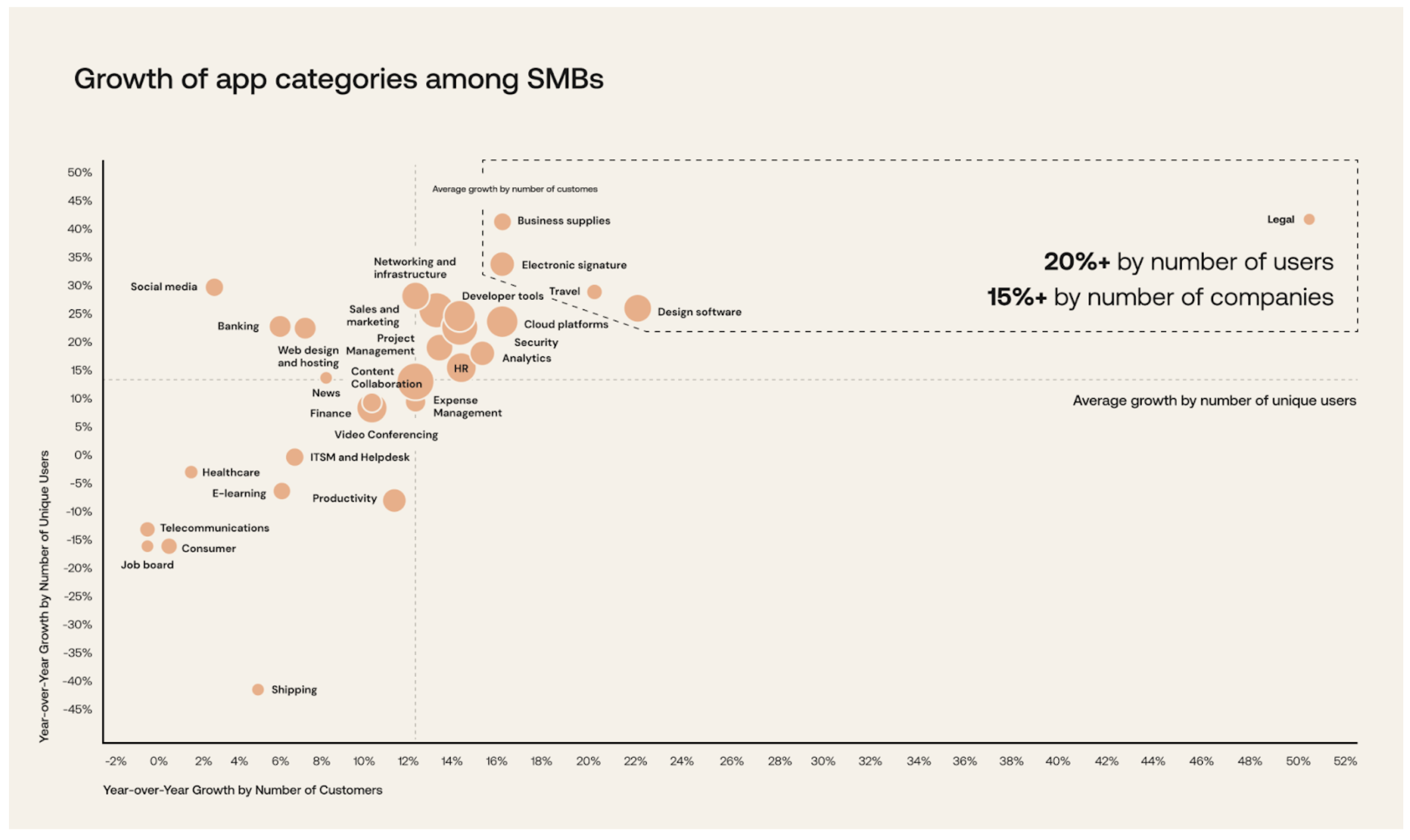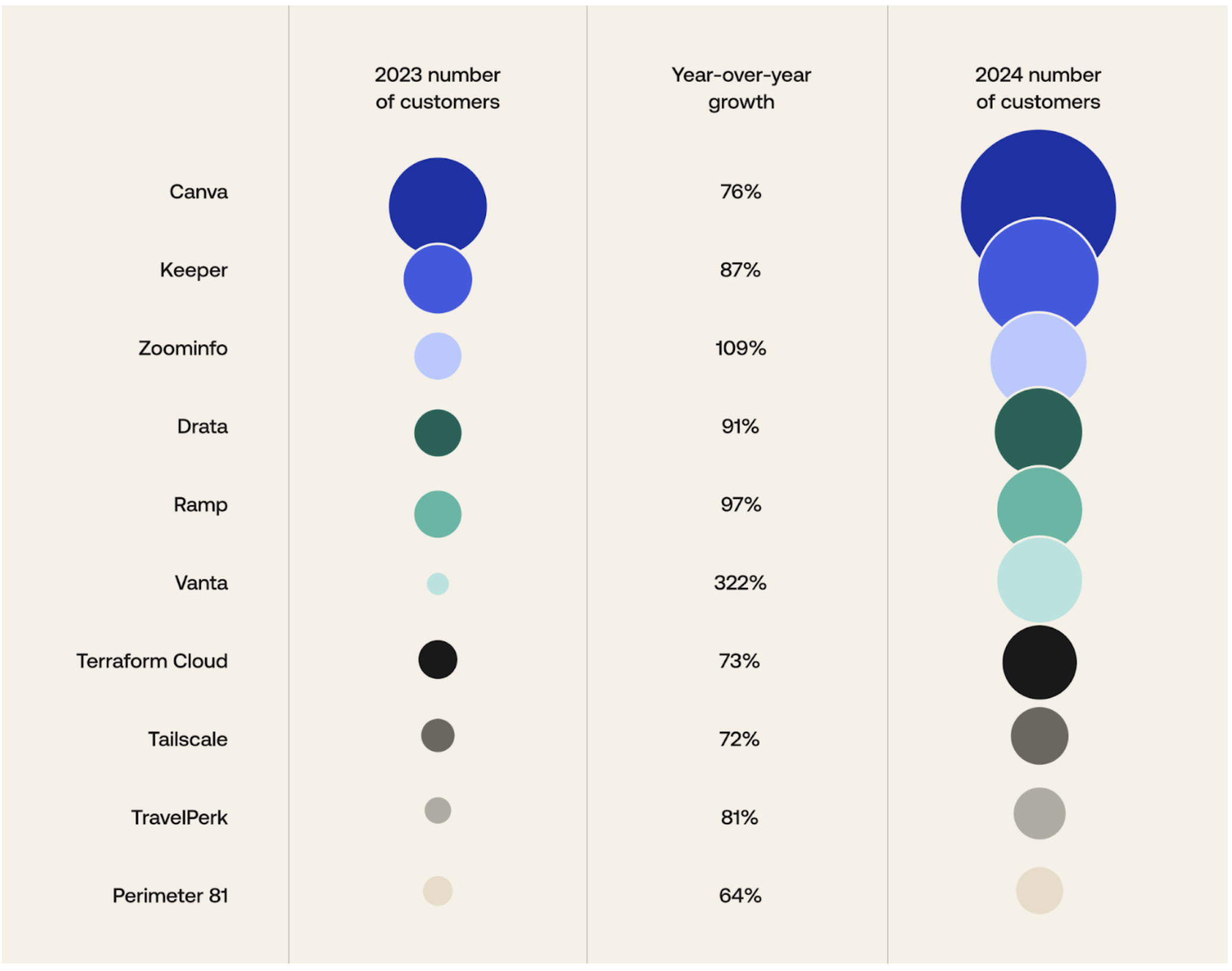In our SMBs at Work 2024 report, we explore how SMBs navigate today’s dynamic app landscape. Powered by anonymized data from over 18,000 companies and how they adopt thousands of applications in the Okta Integration Network, the report details how today’s growing companies are using applications and setting trends.
Small and midsize businesses (SMBs) adopt applications at a quicker pace than larger businesses. But they’re not adopting randomly, and not all app categories saw growth.
In our first blog about the report, we covered large overarching trends. In the second, we explored how SMBs are adapting and thriving in an ever-changing security landscape.
Today, we wanted to find out what apps SMBs are adopting at a faster clip and why.
Where are SMBs investing — and how much?
When everyone is pushed to do more with less, you may begin asking: Do I have enough tech? Too much? Where should I invest to stay competitive?
Looking at the data, we begin to see patterns of what’s been working for SMBs.
SMBs deploy 58 different apps on average
Businesses of all sizes average around 93 apps, and SMBs generally come in below that number. While all sectors show significant YoY growth in app deployment, SMBs on average still deploy 30–60% fewer apps than larger businesses.
The smallest businesses, with 50 or fewer employees, deploy less than that, at around 36 apps. Aggressive expansion is the name of the game for small businesses, who focus on security tools (up 61% YoY by number of unique users), e-signature apps (up 47% by unique users YoY), and travel (up 27% by number of customers).
Though the average number of apps used by SMBs is smaller than larger organizations, SMBs do have a higher app density per employee headcount.
Top app categories show SMBs value design, legal tech, and travel
The top five categories by number of customers show SMBs are doubling down on core functionality. Simply put, SMBs are investing and reinvesting in what already works, whether that’s design software like Canva, Figma, and Adobe Creative Cloud, or legal apps like LegalZoom, DocuSign, and Rocket Lawyer. Travel and office supplies were also popular growth categories, suggesting SMBs are resuming more post-pandemic business travel and resupplying their office spaces.

Growth of categories by unique users and number of customers
What are the most used apps?
Is there an app out there that will help grow your business? What apps are helping other SMBs?
The top apps for SMBs probably won’t surprise you — the workplace workhorses Microsoft Office 365, Google Workspace, and AWS are familiar to most workers and hold top spots when we look at all company sizes as well.
SMBs leaning into legal and security apps
Exactly half of the fastest-growing tools this year were in the compliance and security space. Beyond foundational business apps, we also see SMBs adopting legal tech at a much faster rate (51%) than the overall market (35%). Collaboration apps like Slack and Box also rank higher for SMBs than the market when looking at the top apps overall.
Small businesses (50 or fewer employees) particularly dug into design, security, and travel categories this year. Like their medium-business counterparts, compliance and security helped them stay ahead in part by leveraging automation and features like single sign-on and VPNs/firewalls.
SMBs are willing to adapt as they grow
Interestingly, the data also shows popular apps change over time as a company changes size, introducing new functionality they may not need until a certain size.
For instance, data compliance is one of the hottest app categories this year, with Drata as the number one used app — once SMBs have over 400 employees. In the travel category, companies with 50 employees or fewer mostly used TravelPerk, while companies with 51 employees or more preferred Navan.
Similar preference changes occur — at different transition points — across other categories, including finance, job boards, email, and design software.
What about fastest-growing or disruptive software?
SMBs ramped up fast with a few apps outside the most popular categories. Sales and marketing app ZoomInfo was up 109% YoY growth, and expense management tool Ramp was up 97% YoY.

YoY growth of some of the fastest growing apps for SMBs.
Specifically looking at the 50 most popular apps, Canva is the winner when it comes to fast growth among SMBs, with 76% growth by customers and 171% by unique users.
Showing some appreciation to developers, Grafana (up 64% YoY) is the fastest-growing app in the developer tools category. Other big growers included Heap (up 56%) as the fastest-growing analytics app, and Airtable as the fastest-growing project management app (up 34%).
SMB wisdom and takeaways
There’s a lot of good insight to be gained from analyzing the data and viewing it from above for trends and patterns. While organizations are still doing their best to do more with less, they’re also deploying best-of-breed and most popular apps to ensure they stay competitive in this data-driven economy.
So, what else can we learn or ask ourselves after looking at SMB app use?
- SMBs work with fewer apps than larger organizations: Take a look at your own organization’s app count: Do the apps you use propel your business, support your goals, and secure growth?
- Legal tech was adopted at faster rates than any other categories: Can your organization benefit from legal technology?
- Not all app categories saw growth: As your business grows, changes like RTO can affect your tech stack. Remember to revoke accounts and consider automating your lifecycle management.
- SMBs don’t always use the same apps as larger companies: And the apps that serve them may change over time. Look at what serves your organization now.
- App needs change as a business grows: Consider your growth and roadmap ahead of software investments. Embrace change with supporting technology.
- SMBs’ size allows them to be lean, nimble, and unafraid to try disruptive software: Take advantage of your organizational size to find competitive advantages in software choices.
Learn more:






